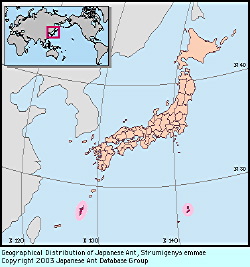
|
species
|
Strumigenys emmae
|
 |
Japanese Name
|
Yofushi-uroko-ari
|
Original Reference
|
|
Emery, C. (1890) Studi sulle formiche della fauna neotropica. Bullettino della Societˆ Entomologica Italiana 22: 38-80.
|
Synonym
|
|
Epitritus emmae Emery, 1890,
Epitritus clypeatus Szab—, 1909,
Epitritus clypeatus var. malesiana Forel, 1913,
Epitritus wheeleri Donisthorpe, 1916,
Quadristruma emmae (Emery): Brown, 1949,
Strumigenys emmae (Emery): Bolton, 1999,
|
Description
|
|
Total length of workers around 1.5 mm. Body color yellowish brown. Apical fork of mandible consisting of 2 spiniform teeth: intercalary denticles between them numbering 2 on the left mandible and 1 or 2 on the right. A spiniform preapical tooth situated at about the apical third of the length of each mandible. Eyes very small, situated at ventral margin of antennal scrobes. Pronotum anteriorly rounding into the sides. Metanotal groove absent. Propodeal spines small, partly incorporated below into posterolateral propodeal lamellae. Hairs on head, mesosoma and petiole mostly scale-like or orbicular.
|
Remarks
|
|
S. emmae is easily distinguished from other Japanese ants by its 4-segmented antennae. A pantropical species, dispersed by human commerce (Brown, 1949b) and natural dispersal (Taylor in Kubota, 1976). Detailed biology is unknown. For recent taxonomic information see Bolton (1983, 1999, 2000). Formerly known as Quadristruma emmae. The genus Quadristruma was synonymized with Strumigenys by Bolton (1999). This species has been recorded in Japan only from Ogasawara Islands (Kubota, 1976; Shindo, 1979).
|
|

Distribution
|
|
Ogasawara Is, Nansei Is (Minami Daito I.); pantropical and subtropical.
|
|
References
|
|
- Brown, W. L., Jr. (1949b. ). Revision of the ant tribe Dacetini: III. Epitritus Emery and Quadristruma new genus (Hymenoptera: Formicidae). . Trans. Amer. Ent. Soc., 75, 43-51.
- Szab—, J. 1909. De duabus speciebus novis Formicidarum generis Epitritus Em. Arch. Zool. (Budapest), 1: 27-28.
- Forel, A. 1913. Wissenschaftliche Ergebnisse einer Forschungsreise nach Ostindien ausgefŸhrt im Auftrage der Kgl. Preuss. Akademie der Wissenschaften zu Berlin von H. v. Buttel-Reepen. II. Ameisen aus Sumatra, Java, Malacca und Ceylon. Gesammelt von Herrn Prof. Dr. v. Buttel-Reepen in den Jahren 1911-1912. Zool. Jahrb. Abt. Syst. Geogr. Biol. Tiere, 36: 1-148.
- Donisthorpe, H. 1916. Epitritus wheeleri, n. sp., an ant new to science; with notes on the genus Epitritus, Emery. Entomol. Rec. J. Var., 28: 121-122.
- Bolton, B. (1983). The Afrotropical dacetine ants (Formicidae). Bull. Br. Mus. Nat. Hist. (Ent.), 46, 267-416.
- Bolton, B. 1999. Ant genera of the tribe Dacetonini (Hymenoptera: Formicidae). J. Nat. Hist., 33: 1639-1689.
- Bolton, B. 2000. The ant tribe Dacetini part 2. Memoirs of the American Entomological Institute, 65: 492-1028.
- Kubota, M. (1976). Dacetine ants from Ogasawara Islands. . Ari, (7), 4.
- Shindo, M. (1979). Ants of the Bonin Islands. . Nature and Insects, 14(10), 24-28 .
|
Editor
|
|
Original text by Kazuo Ogata and Keiichi Onoyama. English translation by Kazuo Ogata, edited by Robert W. Taylor. Rwvised by Masashi Yoshimura.
|
|